Sun, July 11, 2010 | Intelligence and Terrorism Information Center
A Libyan charitable society headed by the son of Muammar Gaddafi organized an aid ship to the Gaza Strip. It set sail on July 10 and is expected to reach the region in four days.
Update – July 11
1. At approximately 1900 hours on July 11 the Amalthea, whose name was changed to Amal (“hope”), set sail for the Gaza Strip from the Greek port of Lavrio (about 50 kilometers, or 31 miles, from Athens). The ship is expected to reach the region in the early morning hours of July 14. The sea voyage was organized by a Libyan charitable society called the Gaddafi International Charity and Development Foundation. It is directed by Saif al-Islam (“the sword of Islam”) Gaddafi, the son of Libyan ruler Muammar Gaddafi.
2. A spokesman for the Greek foreign ministry said that according to the Libyan ambassador to Greece and the ship’s freight agent, its final destination is the Egyptian port of El-Arish. According to the agent, the ship’s documents also show that as its destination (Agence France-Presse, July 10, 2010). However, Egyptian sources said that they have not yet received an official request regarding its arrival in El-Arish. The ship’s cargo consists of basic foodstuffs which already pass freely and without interruption from Israel through the Gaza Strip crossings (See Appendix II).
3. However, several public figures in Libya and the Gaza Strip with links to the flotillas continued to claim that they planned to reach the port of Gaza despite “Israel’s threats.” Another activist claimed that the ship might reach El-Arish. For example:
A. Saif al-Islam Gaddafi, who organized the voyage, said that the ship’s destination was the Gaza Strip and that all reports about other destinations were only attempts to confuse the international community.
B. Faraj al-Ghazali, the general coordinator of the Libyan Committee to Support the Palestinian People said that the ship might reach El-Arish to bring assistance to the Palestinian people. He added that there were ten activists on board and that they were determined to bring the assistance to Gaza, and that they did not care what they would have to sacrifice (Al-Aqsa TV, July 10, 2010).
C. Mahfouz al-Kabariti, a member of Hamas’ Popular Committee to Break the Siege of the Gaza Strip and an advisory member of the Free Gaza Movement, said that the ship would sail directly to Gaza. He said there was no plan to unload the ship at either the port of Ashdod or El-Arish, that the organizers were determined to reach the Gaza Strip and that Israel’s threats would not prevent them from doing so. He added that preparations were being made in the Gaza Strip to receive the ship (Al-Alam TV, July 10, 2010). Jamal al-Khudari, Hamas activist and chairman of Hamas’ Popular Committee to Break the Siege of the Gaza Strip made similar remarks (Al-Aqsa TV, July 9, 2010).
4. The objective of the voyage was described by the Libyan foundation as “breaking the siege.” However, in reality, the basic items on board the ship enter the Gaza Strip freely (See Appendix II). Apparently the true objectives are the following:
A. To exert pressure on Israel after the last flotilla, to force it to agree to allow goods into the Gaza Strip according to demands and rules to be determined by Hamas (materials with military uses banned by Israel; opening a sea lane to the Gaza Strip under Hamas control; Hamas supervision of goods entering the Gaza Strip with the subsequent marginalizing of the Palestinian Authority, making it possible to smuggle weapons into the Gaza Strip in the future).
B. To allow Libya to score points as temporary chairman of the Arab League by showing its “independent” action for the benefit of the Palestinians in the Gaza Strip. The same was done by Turkey, which used the flotilla to establish its image as a regional leader.
C. Possibly to strengthen Saif al-Islam Gaddafi’s position and win him popularity in Libya and the Arab arena before the country’s future inheritance struggles.
Appendix I
The Ship and the Organization Behind Its Voyage
The Ship
1. The Amalthea, whose name was changed to Amal (“hope”), is a cargo ship belonging to the Greek firm ACA Shipping and flies the Moldavian flag. It was built in 1985 at a Japanese shipyard.
2. There are apparently 21 passengers on board, nine of them human rights activists and 12 crew members. One of the passengers is Ayash Draji, an Al-Jazeera TV reporter, who is covering the voyage. The ship’s cargo consists of 2,000 tons of equipment, mostly drugs and basic food items. The organizers of the voyage said that there were few passengers because they wanted to carry the largest possible cargo (Al-Jazeera TV, July 9, 2010).
3. Abd al-Rauf al-Jazaari, a Libyan engineer who is apparently the passengers’ leader, said that the ship was not carrying weapons and that all of its passengers were peace-loving. He said that if the ship was not allowed to reach the port of Gaza the passengers would allow Israel to examine the cargo and transport it to the Gaza Strip, However, Issam al-Sudani, a Moroccan activist passenger aboard the Amalthea, said that the participants were Muslims who “do not fear death” but rather “love to die as shaheeds” (Al-Jazeera TV, July 10, 2010).
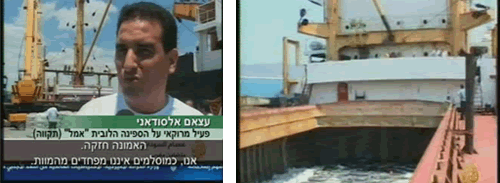
Left: Issam al-Sudani, Moroccan activist passenger. Right: The ship's stern (Al-Jazeera TV, July 10, 2010).
The Gaddafi International Charity and Development Foundation

Logo of the Gaddafi International Charity and Development Foundation. The quotation from the Qur’an reads "Verily Allah has purchased of the believers their lives and their properties for (the price) that theirs shall be the paradise" (Ouran-Sura At-Taubah Verse 111).
4. The Gaddafi International Charity and Development Foundation (GICDF) is an NGO operating in the fields of development and humanitarian, social, economic, cultural and human rights activities.
5. The foundation was established in Geneva in 2003. Its chairman is Saif al-Gaddafi, the son of Libyan ruler Muammar Gaddafi. It also has a general manager, Yussuf al-Suani, who was chosen by the foundation’s economic committee. The foundation has bureaus specializing in various fields which operate in collaboration with other agencies. Its main role is apparently to prepare Gaddafi’s son as his political heir when the time comes.

One of the postings on the Arabic site: "Mr. Saif al-Islam al-Gaddafi speaks in honor of the liberation of 214 members of various jihad groups" (whose release the organization apparently worked for). Gaddafi said that through the organization he was promoting discussion with all the Islamic organizations in Libya to integrate them into society.1
6. The foundation is also the umbrella organization for a number of Libyan NGOs, including:
A. The Libyan National Society for Anti-Drugs and Mental Stimulants, which was established in 1994 as a drug rehabilitation society.
B. The Society for the Vulnerable on Earth, established in Libya in 2001. Its objective is to “[defend] the human rights of individuals and groups who are exposed to oppression because of their political positions advocating just causes, justice and resisting colonization providing that they have not used violence as a means to realize their goals and exposing war and racial discrimination criminals, and taking legal action against them.”[2]
C. The Association for the Brotherhood of the South, a medical and humanitarian relief organization established to aid the Libyan’s southern neighbors in Africa.
D. The Human Rights Association, part of the Gaddafi International Charity and Development Foundation, it recently took action for the rights of released jihadist prisoners [apparently to rehabilitate them].[3]
E. The Association to Fight Landmines.
7. According to Wikipedia, the Foundation intervened in various hostage situations involving Islamic militants and, most notably, the crisis of the HIV trial in Libya, in which foreign doctors operating in Libya were accused of infecting 400 children in a hospital in Benghazi with AIDS. In January 2004, it was instrumental in resolving the compensation issue in relation to the 1989 bombing of UTA flight 772.[4]
Appendix II
List of Basic Goods Entering the Gaza Strip through Israel, 2009-2010
1. Reports from the Libyan ship show that most of its cargo consists of basic foodstuffs such as oil, sugar, and powdered milk. All those goods flow freely into the Gaza Strip through the crossings.
2. The following Israeli data show the goods entering the Gaza Strip through the crossings with Israel in 2009-2010. Most of the quantities are in response to Palestinian demands. The figures indicate the quantities in tons.
| Year | Month | Powdered milk and baby food | Rice | Sugar | Oil |
| January | 602 | 1,239 | 2,475 | 1,720 | |
| February | 738 | 2,710 | 3,973 | 3,229 | |
| March | 744 | 2,299 | 4,794 | 3,372 | |
| April | 198 | 1,619 | 2,982 | 2,073 | |
| May | 637 | 1,142 | 3,261 | 1,811 | |
| 2009 | June | 742 | 2,935 | 5,521 | 1,639 |
| July | 210 | 676 | 4,288 | 504 | |
| August | 82 | 1,263 | 4,677 | 1,328 | |
| September | 133 | 593 | 2,260 | 1,429 | |
| October | 1,009 | 563 | 1,543 | 1,654 | |
| November | 628 | 948 | 1,160 | 2,044 | |
| December | 70 | 1,250 | 3,369 | 1,018 | |
| Total | 5,793 | 16,337 | 40,304 | 21,821 | |
| January | 58 | 387 | 2,618 | 504 | |
| February | 125 | 693 | 1,885 | 1,481 | |
| 2010 | March | 46 | 1,498 | 2,000 | 1,011 |
| April | 324 | 182 | 2,967 | 1,774 | |
| May | 368 | 1,194 | 3,989 | 2,060 | |
| June | 371 | 517 | 3,227 | 1,864 | |
| Total | 1,292 | 4,471 | 16,686 | 8,694 |
Notes:
[1] www.gicdf.org, March 24, 2010.
[2] www.gicdf.org.
[3] The Gaddafi International Charity and Development Foundation website, March 23 and May 10, 2010.
[4] Gaddafi International Foundation for Charity Associations



 RSS
RSS

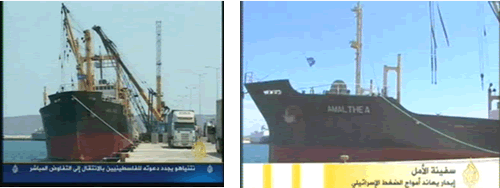


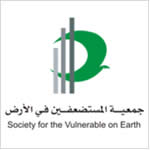
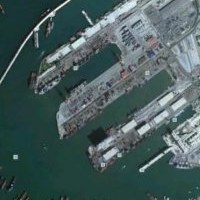

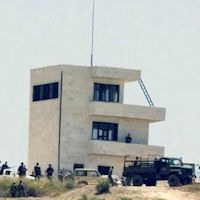






The Libyan Ship Intifada #israel #gaza #flotilla #libya http://j.mp/a7ByWQ
RT @CrethiPlethi: The Libyan Ship Intifada #israel #gaza #flotilla #libya http://j.mp/a7ByWQ
[…] The Libyan Ship Intifada | Middle East Affairs Information Center … […]
[…] 1 For further information read the July 14, 2010 post, “The Libyan Ship Intifada“. […]